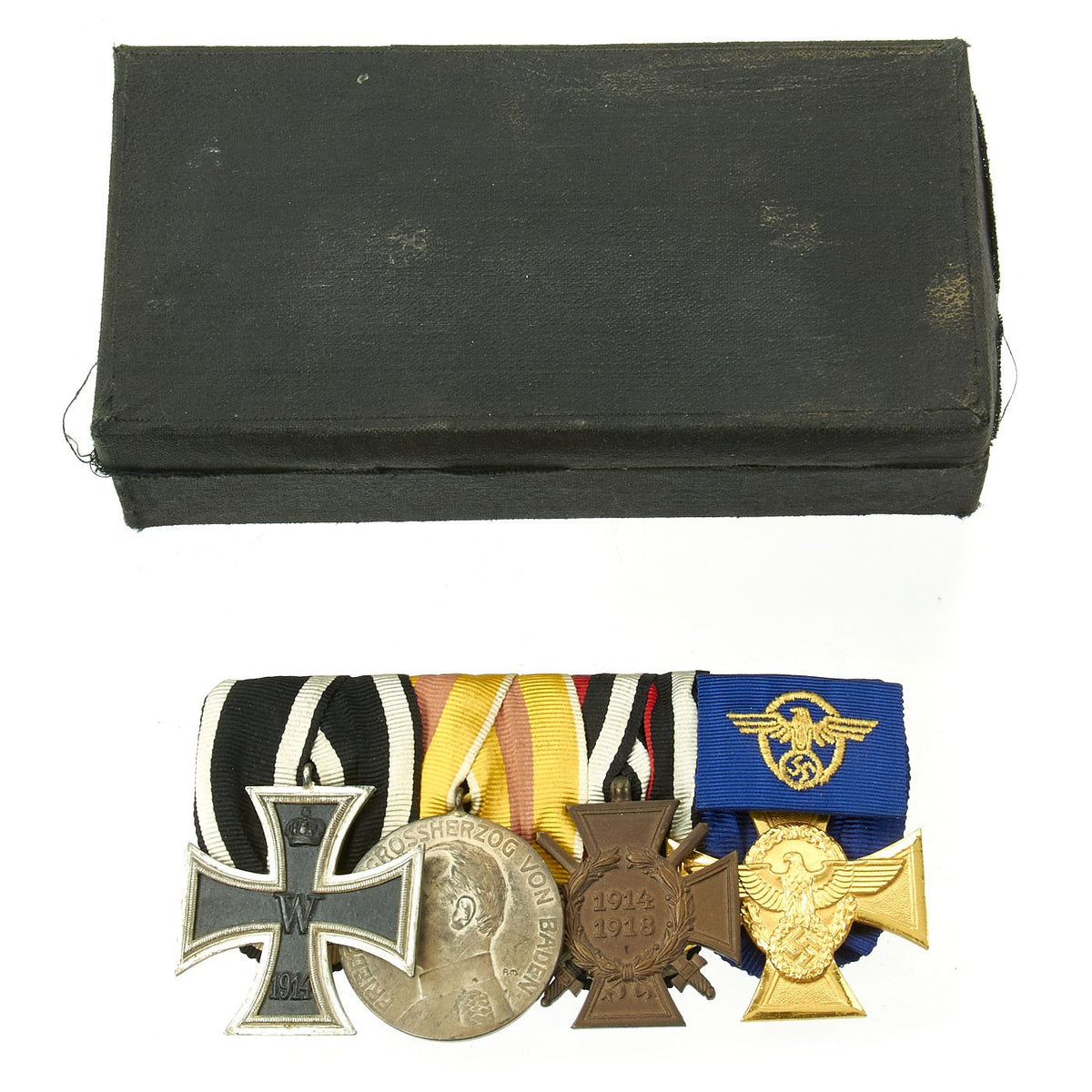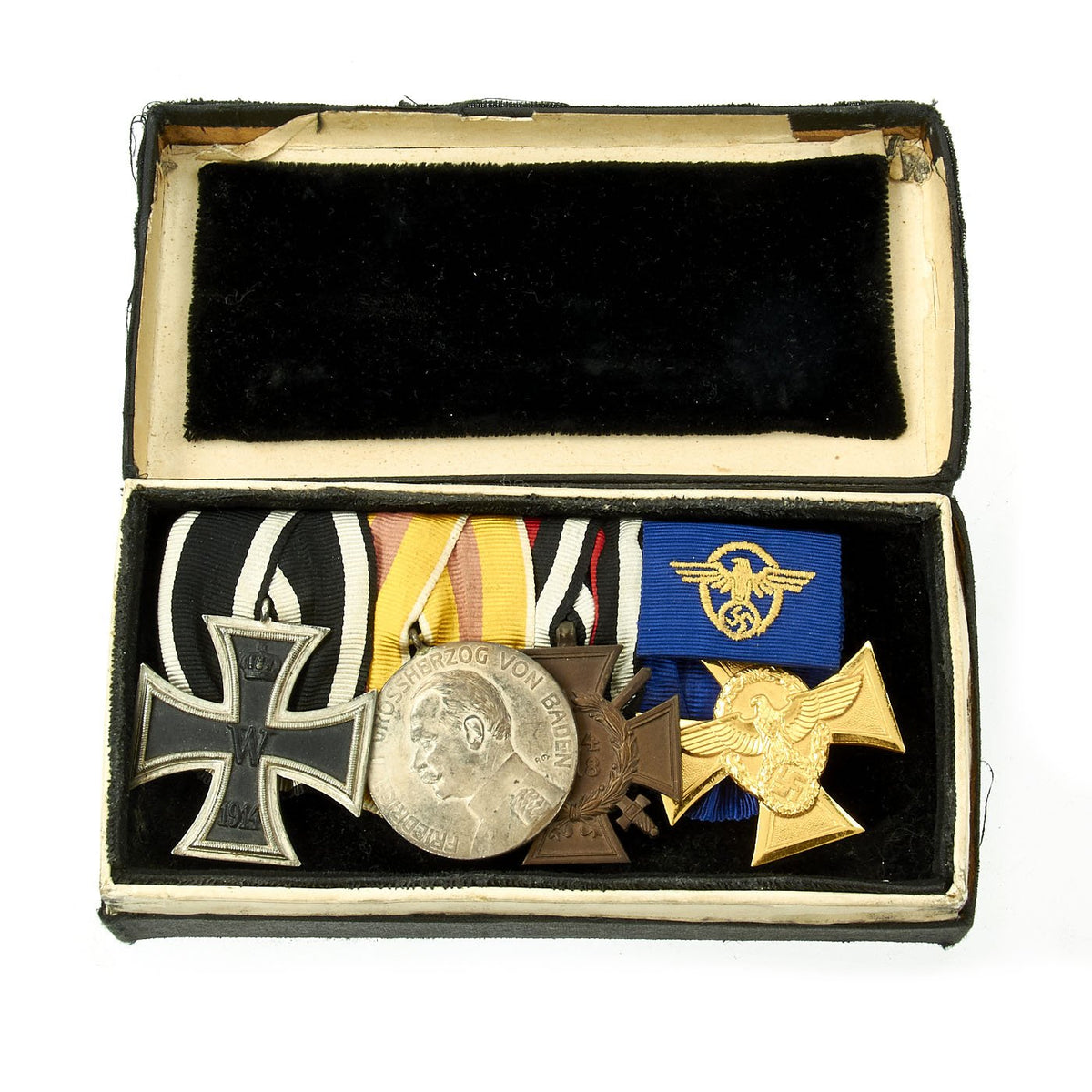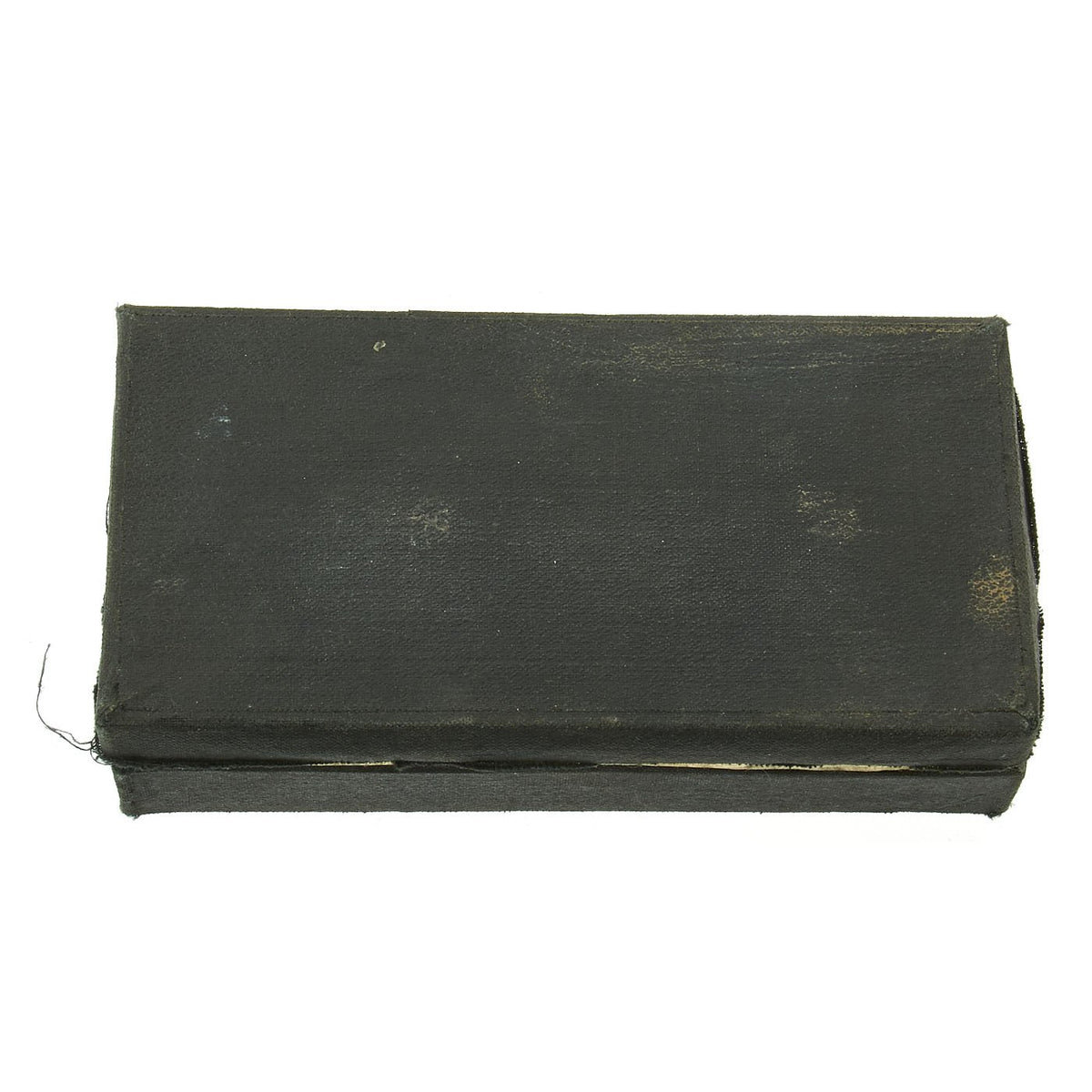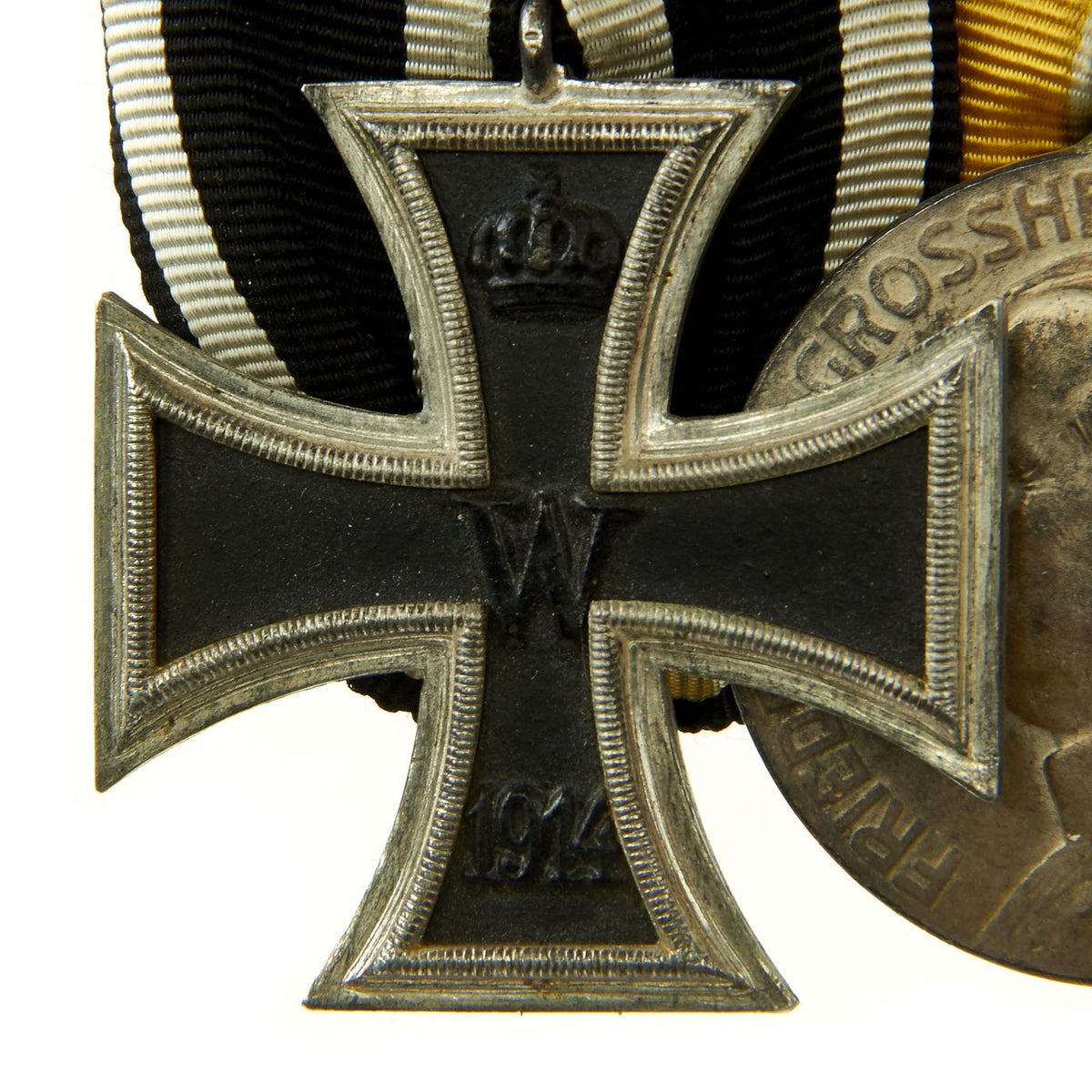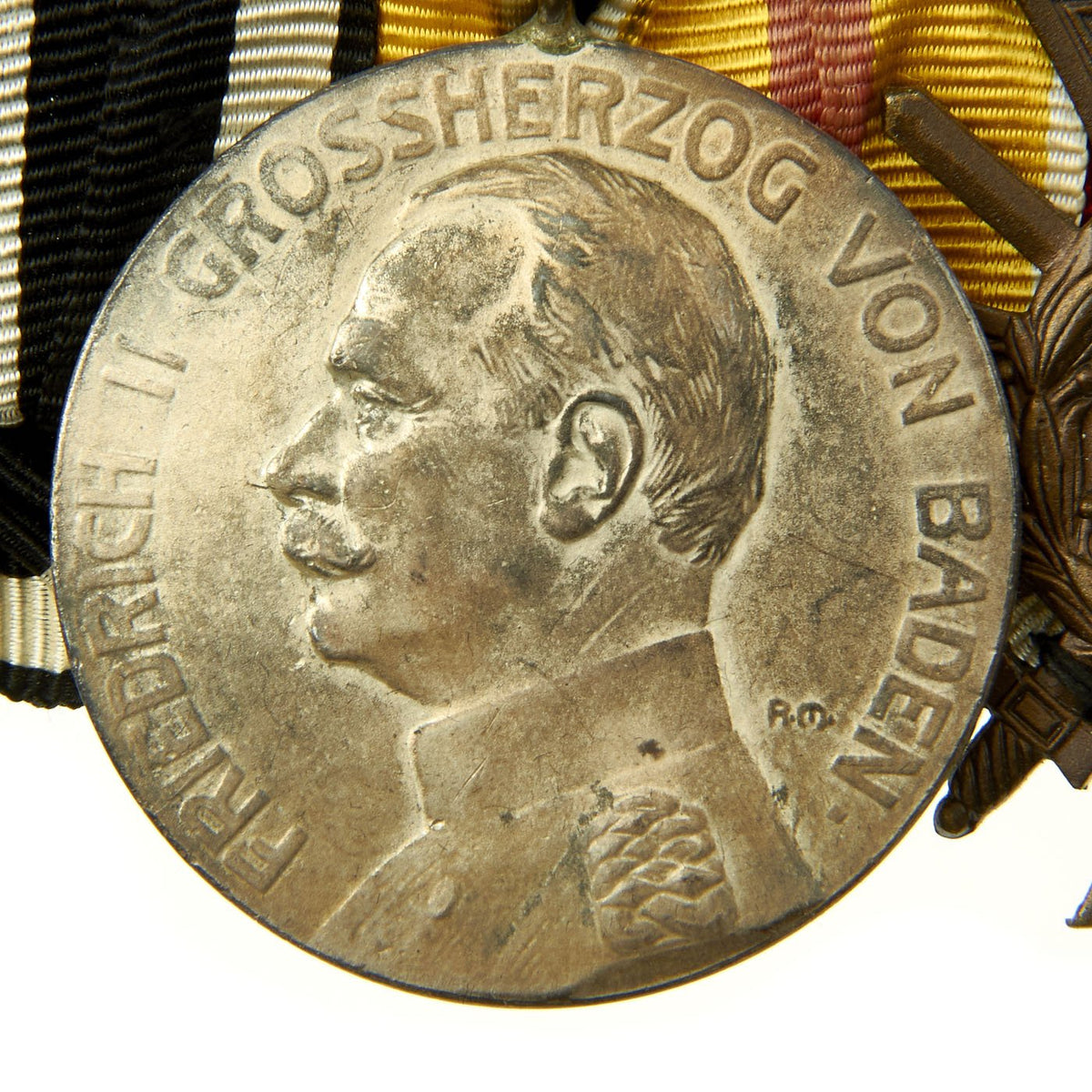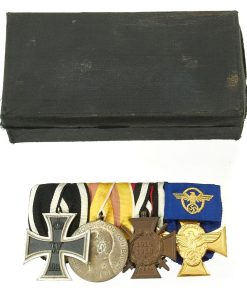Original German WWI / WWII Era Medal Bar with EKII and Baden Silver Medal for Merit – 4 Awards Original Items
$ 495,00 $ 148,50
Original Item: One-of-a-kind. This is a very nice genuine medal bar with original felt lined case. This award bar was owned by a German soldier who fought during WWI, and then served as a police officer during the Weimar republic and into the WWII Era. The colors on some of the ribbons are slightly faded so that red looks orange on the older medals. The medal set also comes in a nice velvet lined case.
The set of 4 medals offered in good condition is mounted on a metal backing board with pin and lined in black wool and consists of the following medals:
– Imperial German WWI Iron Cross 1914 2nd Class Medal
– WWI Baden Silver Medal of Merit Frederick II with Military Ribbon
– German WWI Honor Cross of the World War 1914/1918 (Hindenburg Cross) Medal
– German WWII Police Long Service Cross First Class – 25 Years.
Below is an explanation of each medal in detail:
German WWI Prussian Iron Cross 2nd Class with Ribbon:
Established by Frederick William in 1813 for gallantry in action, the Eisernes Kreuz (EK) decoration was revived several times for later conflicts. The bulk of the issues are divided into 1st and 2nd class versions, but a rare and superior ‘Grand Cross’ was also awarded for successful field commanders. During WW1 the lower decoration was freely awarded with 5½ million second class types issued. Originally, the Iron Cross was an award of the Kingdom of Prussia, however given Prussia’s pre-eminent place in the German Empire formed in 1871, it became an award for all of Germany.
The basic design of the WW1 crosses is a central cross patee struck from iron and mounted in a silver frame which has a raised crenulated decorative border. The obverse of the cross bears the date 1914 under a crowned ‘W’ monogram. Reverse bears an oak leaf cluster with the date of the decoration’s institution, 1813 underneath – the crowned initials of Frederick William are in the top arm above the oak leaf cluster. Suspension for second-class types is by means of a ring, and frequently this ring bears a maker’s stamp.
Please examine the edge seam for authentication, which is not present on reproductions. Iron crosses were commonly constructed from an iron core sandwiched in a surrounding two part silver frame, normally the seam of these two silver parts is visible around the edge of the cross as is seen on this fine example.
Grand Duchy of Baden WWI Silver Medal of Merit Frederick II:
First instituted in 1908, the Silberne Verdienstmedaille (Silver medal of merit) of Frederick II was a civil medal instituted for the WWI Era, rewarded for service to the duchy. In this case, it was awarded on the yellow and red ribbon of the Karl-Friedrich Military Order, indicating it was for a military achievement. The front of the medal has a portrait of Grand Duke Friedrich II in uniform facing left, which is surrounded by FRIEDRICH II GROSSHERZOG VON BADEN, and maker marked R.M.. The reverse is inscribed FÜR VERDIENST (For Merit) with a circular oak wreath around the edge. The award was discontinued in 1918, with the end of the nobility in Germany.
Hindenburg Cross with Crossed Swords (for combat):
The Honor Cross of the World War 1914/1918 (German: Das Ehrenkreuz des Weltkriegs 1914/1918), commonly, but incorrectly, known as the Hindenburg Cross was established by Field Marshal Paul von Hindenburg, President of the German Republic, by an order dated 13 July 1934, to commemorate the distinguished deeds of the German people during the First World War. This was Germany’s first official service medal for soldiers of Imperial Germany who had taken part in the war, and where they had since died it was also awarded to their surviving next-of-kin. Shortly after its issuance, the government of NSDAP Germany declared the award as the only official service decoration of the First World War and further forbid the continued wearing of German Free Corps awards on any military or paramilitary uniform of a state or NSDAP Party organization.
This example is marked on the back with R.v 24 / PFORZHEIM.
German WWII Police Long Service Cross Award:
The Police Long Service Award (Polizei-Dienstauszeichnung) was a long service medal awarded to active members of the German Police during the era of NSDAP Germany as a political award. Professor Richard Klein designed the awards, which varied slightly in design depending on the length of service of the recipient.
On 30 January 1938, Adolf AH ordered the institution of an award for members of the police force who met qualifications based on length of service. The award was given in three grades to men who had served for eight, eighteen, and twenty-five years. The design of all three medals had the police insignia, which consisted of a national eagle emblem surrounded by a wreath, on the obverse side. All three awards were emblazoned with the inscription FÜR TREUE DIENSET IN DER POLIZEI (“For faithful service in the Police”) on the reverse. There was a 40 year award designed and authorized during WWII, but there are no records of anyone earning it due to the end of the War and the NSDAP Party.
This example is the First Class award, for 25 years of service, and is in excellent condition, with the correct blue ribbon, and even has the uniform pin attached.
Fast Shipping with Professional Packaging
Thanks to our longstanding association with UPS FedEx DHL, and other major international carriers, we are able to provide a range of shipping options. Our warehouse staff is expertly trained and will wrap your products according to our exact and precise specifications. Prior to shipping, your goods will be thoroughly examined and securely secured. We ship to thousands clients each day across multiple countries. This shows how we're dedicated to be the largest retailer on the internet. Warehouses and distribution centres can be located throughout Europe as well as the USA.
Note: Orders with more than one item will be assigned a processing date depending on the item.
Before shipping before shipping, we'll conduct a thorough inspection of the items you have ordered. Today, the majority of orders will be delivered within 48 hours. The delivery time will be between 3-7 days.
Returns
The stock is dynamic and we cannot completely manage it because multiple stakeholders are involved, including our factory and warehouse. So the actual stock may alter at any time. It's possible that you may not receive your order once the order has been made.
Our policy is valid for a period of 30 days. If you don't receive the product within 30 days, we are not able to issue a refund or an exchange.
You can only return an item if it is unused and in the same state as the day you received it. You must have the item in its original packaging.
Related products
Uncategorized
Uncategorized
Uncategorized
Uncategorized
Uncategorized
Band of Brothers ORIGINAL GERMAN WWII Le. F.H. 18 10.5cm ARTILLERY PIECE Original Items
Uncategorized
Uncategorized
Australian WWII Owen MK1 Machine Carbine SMG Custom Fabricated Replica with Sling Original Items
Uncategorized
Uncategorized
Uncategorized
Uncategorized
Uncategorized
Uncategorized
Uncategorized
Armored Burgonet Helmet & Polearm from Scottish Castle Leith Hall Circa 1700 Original Items
Uncategorized
Uncategorized
